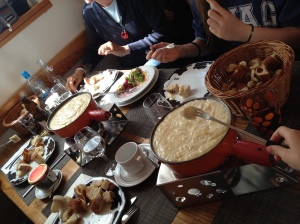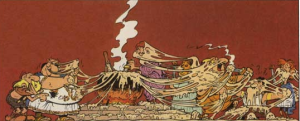If you live in Europe, you know that Fondue is a dish. It is actually a Siwss, Italian and French dish of melted cheese, served in a pot (caquelon) over a portable stove (réchaud) and you eat it by dipping long-stemmed forks with bread into the cheese. Fondue is a great comfort food and the perfect dinner for a cold winter’s night.
Since the 1950s, people use to call fondue also other dishes in which food is dipped into a communal pot of hot liquid: chocolate fondue, where pieces of fruit are dipped into melted chocolate, fondue bourguignonne, in which pieces of meat are cooked in hot oil or broth, fondue chinoise, where pieces of fish are dipped into broth.
The name of this dish comes from the feminine passive past participle of the French word fondre (to melt). It is first attested in French in 1735, in Vincent la Chapelle’s Cuisinier moderne. Vincent la Chapelle was a very famous French master cook.
The earliest known recipe for cheese fondue comes from a 1699 book published in Zurich, under the name “Käss mit Wein zu kochen”* (to cook cheese with wine). Grated or cut-up cheese was melted with wine and eaten by dipping in bread. – Some earlier recipes include eggs, cream (fondue à la genevoise), truffes (fondue à la piemontaise), but the more modern fondue doesn’t include eggs. In Louis Favre’s L’habitation – le vêtement – les aliments. Manuel d’économie domestique à l’usage des écoles secondaires et primaires supérieures (Neuchâtel, 1875), fondue is presented as a Swiss national dish. By adding cornstarch (Maïzena) – introduced in Switzerland in 1905 – the fondue becomes much smoother. – The Swiss Cheese Union did popularize Fondue in the 1930s, by promoting it as a Swiss national dish and increasing the cheese consumption. Nowadays, Fondue is a symbol of Swiss unity and is promoted with slogans like “La fondue crée la bonne humeur” (fondue creates a good mood) and “Fondue isch guet und git en gueti Luune” (fondue is good and creates a good mood”, abbreviated as figugegl.
Different ways to prepare Fondue
Cheese fondue consists of a blend of cheese, wine and spices. The caquelon is first rubbed with a cut garlic clove. Then, white wine, cheese and often kirsch, Öpfelmost or Lemon juice are added and stirred until melted. Cornstarch or other starch can be added; it’s best to mix it with the Kirsch, Öpfelmost or the lemon juice. The mixture is stirred continuously as it heats in the caquelon. Once it’s ready, cubes of bread on a fondue fork are dipped into the mixture. Instead of bread can be also used pieces of potatoes or pears. The temperature of the fondue mixture should be warm enough to keep the fondue smooth and liquid, but not hot that it burns! At the end, there will be a thin crust of toasted (but not burnt!) cheese at the bottom of the caquelon, called la religieuse in French (the nun). It’s hard as a cracker and is almost always lifted out and eaten.

© expatsincebirth
Every region has her own fondue. In the Neuchâtel region, it’s made with Gruyère and Emmental, they also use to do the fondue-moitié-moitié (half-half) with Gruyère and Fribourg vacherin cheese. The fondue vaudoise is made only with Gruyère. Fondue Fribourgeoise is made with Fribourg vacherin (and potatoes are dipped instead of bread), in the “Innerschweiz” they use Gruyère, Emmental and Sbrinz. For the Appenzeller fondue, they use Appenzeller cheese with cream. And there is also a Tomato variation, with Gruyère, Emmental, crushed tomatoes and wine. The spicy fondue is made with Gruyère, red and green peppers and chili or the one with mushrooms is made with Gruyère, Fribourg vacherin and mushrooms. The French alpine fondues are made of Comté savoyard, Beaufort and Emmental (fondue savoyarde) or Mature or mild Comté (fondue Jurassienne).
In the Italian alpine region, the Fonduta valdostana or Fondue à la valdôtaine (typlical of the Aosta Valley) also known as Fonduta piemontese is made with Fontina, milk, eggs and truffles. This Fonduta piemontese shouldn’t be confused with the bagna càuda, a very typical dish from this region, served in a big pan (peila) in the center for communal sharing, like the caquelon for the Fonduta, but is made with garlic, anchovies, olive oil, butter and sometimes cream, where the diners dip raw, boiled or roasted vegetables (carrots, peppers, fennel, celery, cauliflower, artichokes, onions etc.).
Fondue chinoise
The Fondue chinoise is the name for a dish where meat or fish and vegeatbles are cooked in a pot of broth. On the side, you have different sauces to spice the meat. At the end of the meal, the broth is shared among the diners, which now contains an amalgam of all the flavours from the ingredients. There is also a variation of the Fondue Chinoise, called Asian Fondue, Hot Pot. Contrary to the Cheese Fondue, the Fondue with meat or fish is prepared in a metal pot.
Fondue Bourguignonne
The Fondue Bourguignonne is the more traditional Fondue with meat, where the pot is filled with hot oil into which the diners dip pieces of meat to cook. To this kind of meat-fondue are also provided dipping sauces on the side.
Chocolate Fondue
For the Fondue au Chocolat is a dessert fondue, slices of fruit or pastry are dipped into melted chocolate.
Traditions and étiquette
The etiquette prescribes that the pieces of bread (or potato etc.) are only put in the pot once: no double-dipping! The dipping fork is only used to transport the food from the pot to the plate, but never used to eat! You remove the piece with another fork, being careful not to touch the tines of your “eating” fork to your dipping fork…
Fondue étiquette also suggests not to dip at the same time someone else is: dipping should proceed in a clockwise or counterclockwise fashion. This avoids “loosing” the bread, potato, fruit, fish, meat etc. from your dipping fork…
With fondue, some like to drink white wine (fendant) and others prefer black tea. Some do also like to drink kirsch or other kind of spirits during or after the meal.
Tradition says that if one loses his bread (or potato etc.) in the pot, he buys drinks all around, if a woman does, she must kiss the men at the table. Usually people love to make up their own rules for a fondue meal: ask about them before starting!
* Kochbuch der Anna Margaretha Gessner, 1699, cited by Albert Hauser, Vom Essen und Trinken im alten Zürich, cited by Isabelle Raboud-Schüle “Comment la fondue vint aux Suisses”, Annales fribourgeoises 2007
Related articles
- Today’s Recipe: Cheese Fondue (williams-sonoma.com)
- Delicious Ideas for Sweet Fondue (gourmet.answers.com)
- Vegetables with Sumiso Bagna Cauda from ‘Hiroko’s American Kitchen’ (seriouseats.com)
Categories: Culture/Traditions, Switzerland









I want some!!!!
LikeLike
Shall I send it in a box? 😉
LikeLike
YES!!! But make sure it won’t spill… that cheese is far too good to waste 🙂
LikeLike
Bij ons in de familie noemen ze het harde korstje onderin de pan een “nonnenkontje”. Beter niet vertalen,
Fun post! Fondue is on the menu for 25 Dec. because we have the big Christmas meal on the 24th. Happy holidays!
LikeLike
Ha, Misirlou, het “nonnenkontje” noemen ze in het Duits ook “Nonne” of “Grossmutter”, maar zonder “kontje” 😉
Yes, we also have Fondue on the menue this year and probably the 25th too! “Fondue isch guet und git en gueti Luune”: the right thing for family-gatherings.
Let me know if you lost a piece of bread, potato etc. and if so, what you had to do…
Happy Holidays for you too!
LikeLike
We used to have fondue on either Christmas eve or new year’s eve at home, but only the ‘meat in oil’ part (bourguignonne? Didn’t know that)
I loved it as a kid but it strikes me now as a pretty risky family meal..
I remember thinking how odd the name was once I spoke French..
Also, if you wouldn’t have posted a photo of the Asterix album, this article would not be complete =D
LikeLike
Yes, suburp, I realized how risky it is when I got my kids. But we used to only make cheese fondue and the kids were not allowed to use the fondue forks. And we made it without alcohol, for obvious reasons. It works pretty good with lemon juice.
I’m glad you liked the Asterix part. I was even considering to put a longer excerpt of it, but I’m not sure about the copyright etc. (it’s in the vol.16 “Asterix and Obelix in Switzerland”).
LikeLike
I love love love fondue! We used to have fondue chinoise on Heiligabend while spending Christmas in Germany with my grandparents. Thank you for bringing back lovely memories!!
LikeLike
I’m glad it brings back fond memories, Tatu! We also used to have it at my granparents’ when we spent Christmas with them! This year we’ll spend Christmas with my parents and my sister and family and… we’ll have fondue chinoise! Can’t wait 🙂
It’s a nice dish for family gatherings, but to be careful with kids! I wouldn’t do the cheese fondue with alcohol (but lemon juice) and not do the one with hot oil… not even hot broth, to be honest.
LikeLike
Yes, I love how you get to enjoy the company while your food gets slowly ready!
I do hope you have a wonderful time with your family while enjoying your fondue chinoise!
LikeLike
Thanks, Tatu! I wish you the same 😉 Enjoy your family!
LikeLike
What a fun post! I love fondue, and enjoyed learning more about it.
LikeLike
Thanks, Maryanne, I’m glad you liked. We did have a fish Fondue for Christmas this year: so yummy (and if you have as much fish as we did… you can make a yummy bouillabaisse the day after ;-))
LikeLike